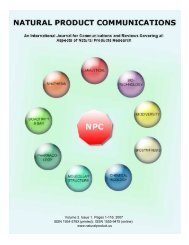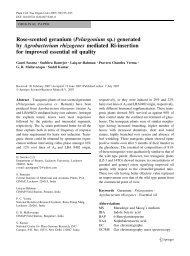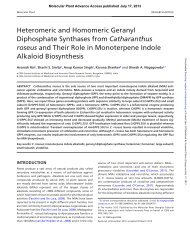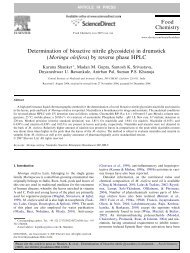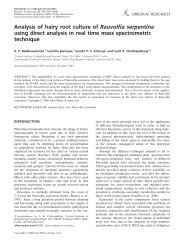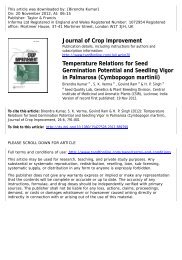Reverse-phase High Performance Liquid ... - CIMAP Staff
Reverse-phase High Performance Liquid ... - CIMAP Staff
Reverse-phase High Performance Liquid ... - CIMAP Staff
Create successful ePaper yourself
Turn your PDF publications into a flip-book with our unique Google optimized e-Paper software.
74<br />
R. K. VERMA ET AL.<br />
B<br />
A 2<br />
d.<br />
Calibration graphs. Standard solutions (1 mg/lO mL) of 1<br />
and 2 were prepared in methanol. Different amounts of<br />
these standards were injected into the HPLC using the<br />
chromatographic conditions described above. The area<br />
counts of peaks (y) and the corresponding concentrations (x)<br />
were used to plot the calibration graphs. The graphs were<br />
linear in the range of 2-50kg for both 1 and 2. The<br />
regression equations were y= 53.15x+ 2 1.3(r= 0.99) for<br />
sennoside A (1) and y=152.05x+22.1 (r=0.99) for sennoside<br />
B (2).<br />
Extraction procedure. Samples of plants of different genotypes<br />
(1 .O g each) were finely powdered and extracted with<br />
water (3 X 25 mL each). The extracts thus obtained were<br />
made up to 100mL with water. Samples were filtered<br />
through a Millipore filter (0.5 km) and a known amount of<br />
each extract was subjected to HPLC analysis under the<br />
above conditions. The contents of 1 and 2 were calculated<br />
using calibration graphs of each compound.<br />
RESULTS AND DISCUSSION<br />
Different compositions of the mobile <strong>phase</strong> were tested<br />
and the desired resolution of the sennosides with symmetrical<br />
and reproducibile peaks and a stable baseline was<br />
achievedby using methanol: water: acetic acid: tetrahydrofuran<br />
(60:38:2:2) as mobile <strong>phase</strong> (Fig. 1). Peaks corresponding to<br />
sennoside A (1) and sennoside B (2) were sharp and well<br />
resolved with retention times of 9.88 and 7.22 min respectively.<br />
The resolution factor between the two peaks was<br />
0.52. As an effective measure of column performance, the<br />
number of theoretical plates for 1 and 2 were 579 and 1084,<br />
respectively. Recoveries of sennoside A and sennoside B<br />
were calculated by spiking the extract with a stock solution<br />
in the mobile <strong>phase</strong> and were found to be 97% and 96%,<br />
respectively. The sennoside contents in different genotypes<br />
of senna cultivated in Lucknow are given in Table 1.<br />
In conclusion, the HPLC method described here is<br />
efficient and simple for the separation and determination of<br />
sennoside A and sennoside B in plant extracts. The method<br />
is an improvement over previous methods since the<br />
retention times of both compounds is reduced, with<br />
Table 1. Contents of sennoside A and sennoside B in five<br />
genotypes of Cassia angustifolia<br />
Genotype Sennoside A(%)’ Sennoside 61%)’<br />
12-121 2.4420.03 1.0620.03<br />
12-7 1.03*0.02 NDb<br />
<strong>CIMAP</strong>-L 1.2620.01 1.0320.02<br />
G19 1.4920.01<br />
0.88* 0.03<br />
G 27 0.89k0.04 ND<br />
a Percentage composition on dry weight basiskSE: n=5.<br />
ND, none detected.




